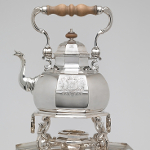Artifact: Plate

Materials: Tin-glazed earthenware (delft)
Dimensions: D: 9 3/4"
Date: ca. 1775
Origin: London, England
Collection: Image Courtesy of The Colonial Williamsburg Foundation
License: All rights reserved
Ledger Entry: Plates

Department: Foodways
Customer: William Baker
Ledger Page: 33
Imported From: Earthenware plates were typically imported from Staffordshire.
Product Description
Plates are a generally flat type of dish used for eating food. They could be simple metal or ceramic objects or highly decorated pieces of art. Dining arrangements at wealthier homes could include many different plates within the same meal, for different dishes, types of food, or parts of the service. Plates were typically made of either pewter or ceramic. Pewter was more expensive but was not likely to break in handling like a ceramic one and retained some value through melting down.
Citation: Philippa Glanville and Hilary Young, ed., Elegant Eating: Four Hundred Years of Dining in Style, (London: Victoria and Albert Museum, 2002).;
Historical Price: 11 shillings for a half dozen; Modern USD: $121
Product Variations
The databases record twenty-one purchases of plates from the store. Plates were most commonly sold in half dozen units and were identified as either pewter or ceramic. “Delph” (tin-glazed earthenware) sold for one shilling two pence. Some were identified as "soup plates." The prices ranged from five pence for half a dozen soup plates to twenty-two shillings and six pence for a dozen soup plates.






